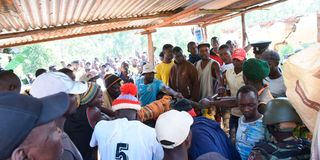Two rescued miners die, search continues for two still trapped

Rescue operations going on at a gold mine that caved in at Sigalagala, in Kakamega County. 12 miners were trapped in the mine on Wednesday night.
Two of the nine miners that were rescued from a gold mine that caved in at Sigalagala, in Kakamega County, have died, while a third miner has died in another gold mine.
Lawrence Shiyonga, 67, died in a separate incident at Emachisiru goldmine in Isukha South Ward in Shinyalu after an open cast mine shaft caved in.
Shiyonga had entered the open shaft with a colleague who managed to escape when the soil started coming down.
Also Read: Nine rescued after Kakamega mine collapses
The rescue mission at Sigalagala continued all of Thursday until Friday at 1am, when the rescuers suspended operations, saying that the soil in the area had “become wild”.
At least 20 people were at the mining site on Wednesday night. 12 of them entered the 60-metre mining shaft before the soil caved in on them.
Ten miners were pulled out of the site on Thursday.
“Unfortunately, two of them, Timothy Bulinda, 22, and Edwin Chesika, 27, succumbed while undergoing treatment. The rescue mission resumed on Friday morning with hopes of finding our two missing colleagues,” said Mr Timothy Mukoshi, the chairman of the Kakamega County Artisanal Mining Association
Oxygen was pumped into the shaft to support the two who were still trapped.
Rescuers indicated that even though they were exercising caution for their safety and that of the victims, the soil had become delicate and was falling into the mining shafts.
Mr Mukoshi said the rescue mission was suspended in the middle of the night due to the delicate condition of the ground.
Local miners are being used in the rescue mission because they understand the construction of the underground channels.
Kakamega County Commissioner Joseph Ondego said the rescue mission had been made difficult because of the delicate state of the ground at the site where the artisanal miners are trapped.
"We did not employ the use of an excavator because the soil around the site has been exhausted and has a lot of underground tunnels. The excavator would likely break the soil and cause more problems,” said Mr Ondego.
The county commissioner banned gold mining in the night in Kakamega after it emerged that most casualties happen at night.
“Many people operating illegally die in the shafts but the cases go unreported because the deaths occur during night time,” reported the commissioner.
Kakamega County has one of the largest mining operations in Western Kenya, even though the mines are considered extremely dangerous, killing dozens due to poor safety precautions and lack of proper supervision.
Every day, miners use makeshift equipment to scoop heaps of soil from the tunnels in search of the precious metal.
Some of the tunnels are 150 feet deep running through the Lirhanda corridor that stretches from Rosterman to Bushiangala and Vihiga County.
Thousands of people in the county are anticipating riches from the mining.
Plans by the government to build a Sh100 million gold refinery in the region have not materialised.
More than 80,000 artisanal miners are looking forward to at the refinery plant, which will come with a processing plant that separates gold from the ore, to help them acquire modern equipment to improve their safety.
Mr Mukoshi said the miners get up to 10kg of gold in a week but middlemen have taken advantage and buy at low prices.
Artisanal miners are paid Sh4,400 per gram of gold sold to middlemen.
Mr Geoffrey Likono, one of the survivors in the Sigalagala incident said the mishap occurred because the soil had been provoked.
He said one of the miners had earlier on Wednesday afternoon cut the rooftop of the shaft causing the soil to drop.
“We entered the mining shaft without knowing what had happened to the soil. We started our mission as usual but a few minutes later, the soil started collapsing after we were about 60 feet deep. In the shaft there are different paths, those who had gone vertically downwards got trapped, while those of us who were in the horizontal routes managed to get out after several hours,” he said.
Mr Likono said he waited for more than six hours before the rescuers reached him.





